Kingdoms throughout the Knowne World have been producing fun dance videos during the Great Quarantine. Below are the links that I have collected, I will add more as I become aware of them. Calontir’s entry coming soon!

![]() It has come to our attention that our email subscription plugin is no longer reliably sending out emails. While we work to fix this, please visit the website regularly, and consider subscribing via RSS. If you have any questions about how to do that, please email me directly and I will assist you.
It has come to our attention that our email subscription plugin is no longer reliably sending out emails. While we work to fix this, please visit the website regularly, and consider subscribing via RSS. If you have any questions about how to do that, please email me directly and I will assist you.
Mathurin Kerbusso
Editor-in-Chief
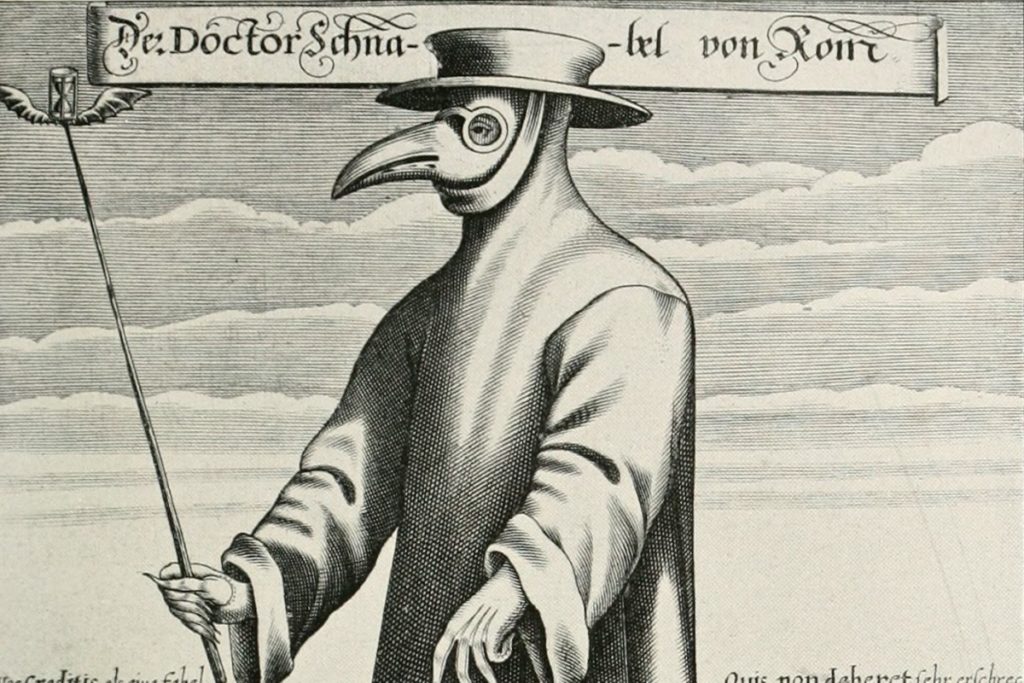 This post will be updated as we are made aware of any classes, etc., for Calontiri and friends.
This post will be updated as we are made aware of any classes, etc., for Calontiri and friends.
Unfortunately many of these resources are only on Facebook, but there are a few that are generally available.
The Calontiri Wiki has a running page of general plague related resources, including Arts & Sciences resources:
http://calontiri.info/index.php?title=Corona_Virus_Quarantine
Calontir.org is maintaining a calendar with only classes and presentations.:
https://www.calontir.org/Calontir-virtual-arts-sciences-classes/
Sir Richard DeBleys has posted several videos for constructing and playing Roman and Norse games:
https://www.youtube.com/channel/UCX7NyGyldBDJu610NaasceQ
THL Konstantia has posted a scribal tutorial
https://www.youtube.com/watch?v=xbIVsK3fNs4&feature=youtu.be
Mistress Giraude had shared her online classes on waxed linen and fabric buttons.
Lucian and Tamar
In evening court:
Nicola Bramante – AoA
Sigvarðr Skarfr – AoA
Gwyneth Rorrigsdottir – Golden Calon Swan
Other court tidings:
2 newcomers received mugs.
Their Excellencies Søren atte Raven and Rúadán del Wich begged leave of Their Majesties to retire from the Baronial seat of Forgotten Sea.
Duchess Aislinn Morcroft and Countess Elena Moreno del Mar are Their Majesties’ Thegns.
Her Excellency Rebecca Beaumont won the Judges’ Choice prize.
Honorable Lady Izza al Zarqa is the new Kingdom A&S Champion.
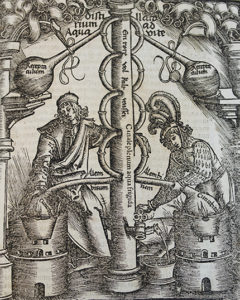
Woodblock from Ulstadt’s 1525 work, Coelum philosophorum seu de secretis naturae liber. Public domain in the US
This is the sixth in a series of educational articles about heraldry in Calontir.
Previously, we discussed inspiration and general principles for your coat-of-arms. Now lets look at the key ingredients.
Tinctures

“Tincture” is the term heralds use for color. There are seven standard tinctures used in heraldry. Technically, the term “color” is only for the darker colors: blue, red, purple, black and green. The term “metal” is used for the light colors: white and yellow (aka silver, gold). The only time we can use other colors like orange or brown is if they’re the natural color of the object, such the wooden handle of a hammer.
Contrast
Identifiably requires good contrast, so we need to avoid putting dark things on a dark background (color-on-color) and light things on a light background (metal-on-metal).
Layers.
The 1st layer of your design is the background. Heralds call it the field. It is possible to have a coat of arms that is just a field!
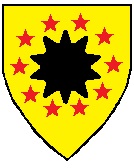
The 2nd layer is made up of the primary, secondary, and/or peripheral charges.
Primary charges are the main motif/s in the central area of the shield, whether a stripe down the middle or a dozen caltrops scattered on the field.
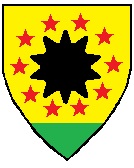
Secondary charges are motifs around the primary charge, for example a circle of stars around a sun. This gets tricky, because that same circle of stars becomes the “primary charge group” if we remove the sun from the design.
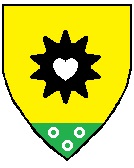
Peripheral charges are motifs that are part of the edge of the shield such as a border or, in this case, a base. They can never be a primary charge because they can never be in the central area of the shield. It is possible to have a coat of arms that only has peripheral charges on the field, so they are different from secondary charges.
The 3rd layer is made up of the tertiary charges. Tertiary charges are motifs that are layered on other motifs, such as rings on a base or a heart on a sun. [Quaternary charges are not allowed.]
 Overall charges are special. They’re a bit like overgrown tertiary charges that overlap the field. They have weird rules because of that, and it’s hard to make good designs with overall charges – they have to overlap the field enough, they can’t cover up too much of the other charges, etc. In this case, it’s hard to see that there’s a sun hiding underneath the cross.
Overall charges are special. They’re a bit like overgrown tertiary charges that overlap the field. They have weird rules because of that, and it’s hard to make good designs with overall charges – they have to overlap the field enough, they can’t cover up too much of the other charges, etc. In this case, it’s hard to see that there’s a sun hiding underneath the cross.
If this is starting to get confusing, there are lots of resources to help. See “Heraldic Helpers“, come meet us at a consult table near you, or try out the Virtual Consult Table!
At your service,
Sofya la Rus, Habicht Herald
Calontir Heraldic Education Deputy
habicht@calontir.org
![]() In line with our goal of more reader reporting, I am requesting papers from the upcoming Clothiers’ Seminar and Queen’s Prize Tournament.
In line with our goal of more reader reporting, I am requesting papers from the upcoming Clothiers’ Seminar and Queen’s Prize Tournament.
If you have documentation for your class or QPT entry, please consider sending it in for publication in the Falcon Banner.
I am planning on taking photos of the Walk Through History at Clothiers, and select photos at QPT, but I may not catch everything, or photography what you think is important about your project, so don’t hesitate to send your photos as well.
Please send all submissions to mathurin@falconbanner.com. If your material is too large for email, let me know and we will set up a Google Drive folder for you.
Mathurin Kerbusso, Editor

Adoration of the Magi by Bartolomé Esteban Murillo
As it grew dark on Christmas Eve and people filed into church for the Vespers service, the late afternoon/evening service now held around 4 pm, the Christmas season officially began for medieval folk, at least for those in the Christian West.
Unlike us, who begin our Christmas season before the holiday, at Thanksgiving or even earlier, our medieval counterparts began the season with the religious events surrounding Christmas Eve and Christmas Day. Decorations were put up right before Christmas, often on Christmas Eve. I imagine our medieval alter-egos would have frowned on the concept of decorating to celebrate the birth of Jesus before Advent even began.
We live in a secular country that notes holidays like Ramadan and Yom Kippur on its calendars. It’s hard to truly comprehend how much religion and the Christian liturgical calendar were part of everyday medieval life. For the common folk the liturgical calendar was more important than the Julian calendar. Letters were dated by the holy day or week, for example “written on St. Catherine’s Day” or “on the Saturday before Ash Wednesday.” Few used the complicated Roman calendar to date personal correspondence (“vij kalendas Februarias”). Everyone knew when Holy Rood Day or Michaelmas was.
The first day of Christmastide, December 25, was followed by the second day, the Feast of St. Stephen, then the third day, the feast of St. John the Evangelist, and so on. On the evening before the twelfth day of Christmas, January 5, the celebration of Epiphanytide began. The Feast of the Epiphany, which celebrated the visit of the three wise men, or three kings, to the baby Jesus, also celebrated the baptism of Christ during SCA period and to a lesser extent, the miracle at the wedding at Cana. It ended eight days later, on January 13.
Christmas, Epiphany, Lady Day, All Saints’ Day, the feasts of the Ascension of Christ and the Assumption of the Virgin Mary are some of the most important Church holy days, known as Solemnity Days. These days outrank regular saints’ days and memorials. The celebration of Solemnity Days always began the day before, at Vespers.
All these Christian holy days, which is, of course, where our word holiday comes from, were part of the liturgical calendar for the year. Some, like Christmas, were fixed dates. Others, like the first Sunday of Advent, were moveable dates that were computed from when another Church holiday fell on the calendar. Easter, that most complicated Church holiday, determined when many of the other church events took place. I suspect that most people didn’t worry about computing each year’s calendar and simply let their churchmen tell them when to feast and when to fast.
When exactly did Christmas end? Christmastide ended on Twelfth Night. Shakespeare mentions people taking down the Christmas decorations on Twelfth Night. If you include Epiphanytide, you extend the holiday season another week. But in some places they remove Christmas decorations on Candlemas Eve (Feb. 1), and some calendars describe Feb. 1 as the end of the Christmas season. Christians believe February 2 is when Jesus was presented in the Temple and when Mary was purified, so continuing the season of the birth of Jesus until February 2 has some logic to it. However, it seems to be more of a post-SCA period practice.
So what happened after Epiphanytide? The weeks between major Church events were known as Ordinary Time. These weeks were numbered, from one to 34, and usually began the Monday after a significant church time period. For example, Ordinary Time begins on January 14, the day after the end of Epiphanytide, with the first Sunday of Ordinary Time on January 20 this year.
Below is part of a reconstructed medieval liturgical calendar. Since my persona is 12th century English, it represents the holidays and saints’ days my persona would have known.[i] It covers the time from the birth of Jesus to his presentation in the Temple.
Reconstructed Medieval Liturgical Year
Constructed Using 2018-2019 as the Example
Dates marked with (M) are moveable feasts or days of worship. Dates in bold are Solemnity feasts[ii], Church events deemed more important than regular feast days. Optional or obligatory memorial observances are in italic.
| Christmastide (beginning of a week off for the peasantry) | |||
| Christmas/Feast of the Nativity of Jesus Christ | Dec. 25, 2018 | ||
| Feast of St. Stephen | Dec. 26 | ||
| Feast of St. John the Evangelist | Dec. 27 | ||
| Childermas (Feast of the Holy Innocents) | Dec. 28 | ||
| St. Thomas Becket (from 12th century) | Dec. 29 | ||
| Feast of the Circumcision (eight Roman days after Christmas) | Jan. 1, 2019 | ||
| Twelfth Night (eve of the 12th day of Christmas/end of Christmas) | Jan. 5 | ||
| Epiphanytide[iii] | |||
| Feast of the Epiphany (Visit of the Magi/Baptism of Christ) | Jan. 6 | ||
| End of Epiphanytide | Jan. 13 | ||
| Ordinary Time (ordinal – the counted weeks)[iv] | Jan. 14 | ||
| (Begins on January 14 this year) | |||
| First Sunday of Ordinary Time | Jan. 20 | ||
| Second Sunday of Ordinary Time | Jan. 27 | ||
| Candlemas/Feast of the Presentation of Christ/Feast of the Purification of the Virgin | Feb. 2 | ||
[i] Modern liturgical calendars have additional holy days or have removed or added saints’ days. For example, the celebration of the baptism of Jesus is now held on the Sunday after Epiphany in the Roman Catholic Church.
[ii] Solemnities replace Sunday services when they fall on a Sunday. Celebration of Solemnity feasts begins the night before at Vespers.
[iii] Modern church calendars consider Epiphanytide a subset, or part of, Christmastide.
[iv] Ordinary Time runs from the Monday after the Sunday that follows Epiphany (January 13 this year) to the Tuesday before Ash Wednesday (March 5 this year), then resumes on the Monday after Pentecost Sunday (June 10 this year) and concludes before First Vespers of the First Sunday of Advent (Dec. 1 in 2018).
You must be logged in to post a comment.